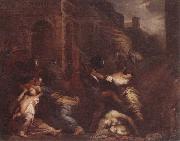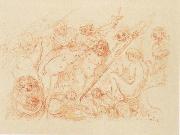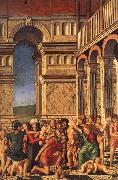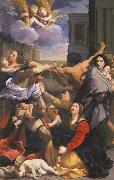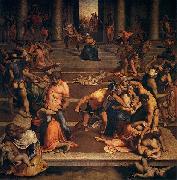Wholesale Oil Painting Reproductions No Minimum and Door to Door! |
|||||||||||
|
|
|||||||||||

|
|||||||||||
|
|
|
||||||||
All unknow artist Oil Paintings |
||||||||
|
|
||||||||
|
|
||||||||
|
Artist Introduction: |
||||||||
|
|
||||||||
|
The massacre of the innocents Painting ID:: 27524 |
mk56
oil on canvas
Attributed to Giovanni Battista Merano
|
|||||||
Height Width |
INS/CM Quality |
|||||||
|
X |
| |||||||
|
|
||||||||
All James Ensor Oil Paintings |
||||||||
|
|
||||||||
|
|
||||||||
|
Artist Introduction: Belgian
1860-1949
Belgian painter, printmaker and draughtsman. No single label adequately describes the visionary work produced by Ensor between 1880 and 1900, his most productive period. His pictures from that time have both Symbolist and Realist aspects, and in spite of his dismissal of the Impressionists as superficial daubers he was profoundly concerned with the effects of light. His imagery and technical procedures anticipated the colouristic brilliance and violent impact of Fauvism and German Expressionism and the psychological fantasies of Surrealism. Ensor most memorable and influential work was almost exclusively produced before 1900, but he was largely unrecognized before the 1920s in his own country. His work was highly influential in Germany, however: Emil Nolde visited him in 1911, and was influenced by his use of masks; Paul Klee mentions him admiringly in his diaries; Erich Heckel came to see him in the middle of the war and painted his portrait (1930; Cologne, Wallraf-Richartz-Mus.); Alfred Kubin owned several of his prints, while Marc Chagall and George Grosz also adapted certain elements from Ensor. All the artists of the Cobra group saw him as a master. He influenced many Belgian artists including Leon Spilliaert, Rik Wouters, Constant Permeke, Frits van den Berghe, Paul Delvaux and Pierre Alechinsky. |
||||||||
|
|
||||||||
|
|
The Massacre of the Innocents Painting ID:: 37436 |
mk126
|
||||||
Height Width |
INS/CM Quality |
|||||||
|
X |
| |||||||
|
|
||||||||
All RENI, Guido Oil Paintings |
||||||||
|
|
||||||||
|
|
||||||||
|
Artist Introduction: Italian Baroque Era Painter, 1575-1642
Italian painter, draughtsman and etcher. He was one of the greatest and most influential of the 17th-century Italian painters, whose sophisticated and complex art dominated the Bolognese school. A classicizing artist, deeply influenced by Greco-Roman art and by Raphael but also by the mannered elegance of Parmigianino's paintings, he sought an ideal beauty; his work was especially celebrated for its compositional and figural grace. In his religious art he was concerned with the expression of intense emotion, often charged with pathos; according to his biographer Malvasia, he boasted that he 'could paint heads with their eyes uplifted a hundred different ways' to give form to a state of ecstasy or divine inspiration. |
||||||||
|
|
||||||||
|
|
The Massacre of the Innocents Painting ID:: 40415 |
mk156
c.1611
Oil on canvas
268x170cm
|
||||||
Height Width |
INS/CM Quality |
|||||||
|
X |
| |||||||
|
|
||||||||
All Girolamo Mocetto Oil Paintings |
||||||||
|
|
||||||||
|
|
||||||||
|
Artist Introduction: Italian Painter, ca.1470-1531,Italian engraver, painter and designer of stained glass. He was born into a family of glass painters, and, although there is no documentary evidence that he worked outside Venice, his early paintings and engravings show the influence of Domenico Morone and of Mantegna and his circle, which would suggest that Mocetto's training may not have been exclusively Venetian. His artistic evolution is most clearly seen in a comparison of early works still close to Morone, such as a series of three engravings of the Battle between Israel and the Amalekites (see Hind, nos 719-20) or the painting of the Battle (Pavia, Pin. Malaspina), to works of a few years later, such as the two small paintings of the Massacre of the Innocents (London, N.G.; see fig.) and the engravings of Pagan Sacrifices (H 726-7), the Metamorphosis of Amymone (H 728) and the Calumny of Apelles (H. 727), all datable to c. 1500. In the later works, whole passages or motifs are copied or adapted from drawings and engravings by Mantegna. Mocetto may have had direct contact with the court of Mantua (the Metamorphosis of Amymone is an allegory of the city of Mantua); two engravings dating from the first years of the 16th century, St John the Baptist (H 724) and Judith with the Head of Holofernes (H 725), |
||||||||
|
|
||||||||
|
|
The Massacre of the Innocents Painting ID:: 42918 |
mk170
1495-1500
Oil on canvas
67.9x44.5cm
|
||||||
Height Width |
INS/CM Quality |
|||||||
|
X |
| |||||||
|
|
||||||||
All RENI, Guido Oil Paintings |
||||||||
|
|
||||||||
|
|
||||||||
|
Artist Introduction: Italian Baroque Era Painter, 1575-1642
Italian painter, draughtsman and etcher. He was one of the greatest and most influential of the 17th-century Italian painters, whose sophisticated and complex art dominated the Bolognese school. A classicizing artist, deeply influenced by Greco-Roman art and by Raphael but also by the mannered elegance of Parmigianino's paintings, he sought an ideal beauty; his work was especially celebrated for its compositional and figural grace. In his religious art he was concerned with the expression of intense emotion, often charged with pathos; according to his biographer Malvasia, he boasted that he 'could paint heads with their eyes uplifted a hundred different ways' to give form to a state of ecstasy or divine inspiration. |
||||||||
|
|
||||||||
|
|
The Massacre of the Innocents Painting ID:: 55757 |
mk244
268x170cm
Oil on canvas
|
||||||
Height Width |
INS/CM Quality |
|||||||
|
X |
| |||||||
|
|
||||||||
All Daniele Da Volterra Oil Paintings |
||||||||
|
|
||||||||
|
|
||||||||
|
Artist Introduction: Italian Mannerist Painter and Sculptor, 1509-1566
Italian painter, stuccoist and sculptor. Much of the fascination of his career resides in the development of his style from provincial origins to a highly sophisticated manner, combining the most accomplished elements of the art of Michelangelo, Raphael and their Mannerist followers in a distinctive and highly original way. He provided an influential model for numerous later artists in Rome. |
||||||||
|
|
||||||||
|
|
The Massacre of the Innocents Painting ID:: 84564 |
Date 1557(1557)
Medium Oil on wood
Dimensions Height: 51 cm (20.1 in). Width: 42 cm (16.5 in).
cjr |
||||||
Height Width |
INS/CM Quality |
|||||||
|
X |
| |||||||
|
|
||||||||
All Daniele Da Volterra Oil Paintings |
||||||||
|
|
||||||||
|
|
||||||||
|
Artist Introduction: Italian Mannerist Painter and Sculptor, 1509-1566
Italian painter, stuccoist and sculptor. Much of the fascination of his career resides in the development of his style from provincial origins to a highly sophisticated manner, combining the most accomplished elements of the art of Michelangelo, Raphael and their Mannerist followers in a distinctive and highly original way. He provided an influential model for numerous later artists in Rome. |
||||||||
|
|
||||||||
|
|
The Massacre of the Innocents Painting ID:: 88415 |
1557(1557)
Medium Oil on wood
cyf |
||||||
Height Width |
INS/CM Quality |
|||||||
|
X |
| |||||||
|
|
||||||||
|
Prev Next
|
||||||||
|
|
||||||||
|
Related Paintings to Daniele Da Volterra :. |
||||||||
|
|
||||||||
|
CONTACT US |
